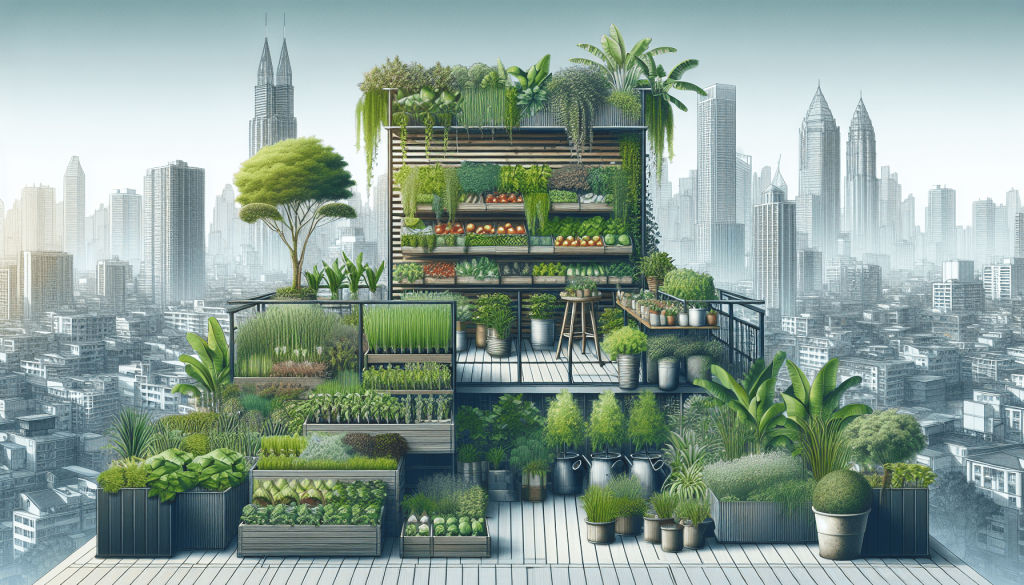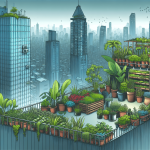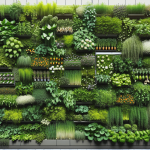This post may contain affiliate links. As an Amazon Associate, we may earn commissions from qualifying purchases.
Rooftop gardening is an innovative and rewarding way to make the most of your urban living space, allowing you to grow your own vegetables, herbs, and flowers high above the hustle and bustle of the city. In this article, “What Are The Benefits And Challenges Of Rooftop Gardening?” you’ll delve into the multifaceted advantages that come with cultivating a green sanctuary on your rooftop, such as improved air quality, reduced energy costs, and the joy of harvesting fresh produce. However, it’s not without its hurdles—structural considerations, water management, and weather exposure pose significant challenges. Join us as we explore these aspects to help you determine if rooftop gardening is the right endeavor for you. Have you ever looked at your roof and thought, “What could I do with all this space?” Maybe you have a dangling hope of transforming your rooftop into a green oasis. If so, you’re not alone. Rooftop gardening is catching on rapidly, not just as a hobby but as a pioneering solution to urban problems. But is it as easy and rewarding as it sounds?
The Alluring Benefits of Rooftop Gardening
Rooftop gardening has a magnetic appeal, drawing in city dwellers who long for a sprinkle of nature amidst the concrete jungle. Here are some of the compelling reasons you might want to jump on the rooftop garden bandwagon.
Provides Fresh Produce
Imagine scoring fresh, organic vegetables without setting foot in a supermarket. Yes, it’s pretty idyllic. A rooftop garden allows you to cultivate an assortment of fruits, vegetables, and herbs. You know what you’re eating because you grew it yourself. This means fresher, healthier, and safer food options.
Adds Aesthetic Value
Do you know what stands out against a skyline of dull, monotonous buildings? A lush, vibrant rooftop garden. It creates a captivating visual appeal, adding some much-needed greenspace to an otherwise drab cityscape. Besides elevating the aesthetics, it can also increase the value of your property. Who knew tomatoes could be a financial asset?
Energy Efficiency
Rooftop gardens are excellent for energy conservation. They act like natural insulators, reducing the need for artificial heating and cooling. Your air conditioner and heater will thank you, and so will your wallet when the utility bill comes through.
Environmental Benefits
Rooftop gardens are nature’s air purifiers. They absorb pollutants, improve air quality, and help combat the heat island effect by cooling the air around them. Those leaves up there? They’re mini climate warriors. Plus, they’re surprisingly good at managing rainfall. Stormwater runoff? Reduced. Soil erosion? Mitigated.
Mental and Physical Well-being
Tending to a rooftop garden can be an unexpected form of therapy. It has the power to reduce stress, improve mental health, and even boost physical activity levels. Pulling weeds may not replace your gym routine, but it can get you out in the fresh air and moving around.
Social Interaction
If you’re a social butterfly, a rooftop garden can be a fabulous conversation starter. Hosting friends for a garden tour or potluck can foster stronger social connections, making your rooftop garden a communal space.
The Daunting Challenges of Rooftop Gardening
Now that you’re envisioning your own urban Eden, let’s talk about the hiccups you might face along the way. Nothing worthwhile comes easy, and rooftop gardening is no exception.
Structural Integrity and Load-bearing Capacity
Before you throw grapevines onto your roof, let’s chat about some cold, hard facts. Your rooftop must be inspected to ensure it can support the additional load. Soil, plants, and garden structures can add considerable weight, and you don’t want your flourishing garden crashing into your living room.
Waterproofing
Water may be a plant’s best friend, but it’s a rooftop’s worst enemy. Ensure your roof is adequately waterproofed to avoid leaks. Any breach could mean a nightmare of mold, decay, and costly repairs.
Wind Exposure
Your rooftop is like the pinnacle of a wind turbine. High winds can be brutal on plants, displacing soil and damaging foliage. You may need windbreakers or sheltered areas to protect your delicate greens.
Maintenance
Let’s not sugarcoat it: rooftop gardens require a fair bit of maintenance. Regular watering, weeding, and pest control are non-negotiable. Oh, and don’t forget the seasonal shuffle—swapping out plants as per the changing weather. If you’re not genuinely committed, your rooftop could quickly turn from Eden to a barren wasteland.
Initial Costs
Setting up a rooftop garden isn’t exactly a budget-friendly endeavor. Costs can add up, from structural modifications and soil to plants and garden furniture. Expect a relatively steep initial investment, although you might recoup some of that through energy savings and increased property value.
Limited Plant Choices
Your rooftop is a harsh environment. Only certain plants with excellent sun and wind tolerance will thrive up there. You’ll need to be choosy about what you grow. Violets, hydrangeas, and other shade-lovers? Probably not your best bet for roof life.
Water Management
Given the sun exposure and wind intensity, rooftop gardens can dry out faster than ground-level gardens. You’ll need an effective irrigation system, which could be yet another cost and maintenance factor.

Types of Rooftop Gardens
If you’ve stuck around this far, you’re likely serious about the venture. Let’s explore the various types of rooftop gardens you can consider.
Extensive Green Roofs
These are minimalistic. They feature shallow soil (usually less than six inches) and require relatively low maintenance. You’re looking at drought-resistant plants, mainly sedums and other hardy species that can withstand the intense sun.
| Feature | Extensive Green Roofs |
|---|---|
| Soil Depth | Less than 6 inches |
| Plant Types | Drought-resistant, hardy species |
| Maintenance | Low |
| Cost | Relatively low |
Semi-Intensive Green Roofs
This is the middle ground—more soil depth (around 6–12 inches) and higher plant variety. You get more creative freedom, but the trade-off is an increase in maintenance and a slightly higher cost.
| Feature | Semi-Intensive Green Roofs |
|---|---|
| Soil Depth | 6–12 inches |
| Plant Types | Larger variety of perennials and grasses |
| Maintenance | Moderate |
| Cost | Medium |
Intensive Green Roofs
These are basically full-fledged gardens on your roof with deep soil layers (12 inches or more), allowing for trees, shrubs, and even small water features. The kicker? They require extensive maintenance and cost. But oh, the possibilities!
| Feature | Intensive Green Roofs |
|---|---|
| Soil Depth | More than 12 inches |
| Plant Types | Trees, shrubs, a wide variety |
| Maintenance | High |
| Cost | High |
Challenges Addressed and Solutions
Facing the challenges of rooftop gardening doesn’t mean you have to abandon ship. Let’s look at how to tackle these obstacles head-on.
Structural Integrity
Solution? Get a professional to assess your rooftop. Licensed structural engineers can determine your roof’s load-bearing capacity and suggest necessary reinforcements.
Waterproofing
Install waterproof membranes beneath your soil and plant layers. Regular inspections can help you catch any leaks early. After all, an ounce of prevention is worth a pound of cure.
Wind Exposure
Erect barriers or use taller plants to create wind buffers. Position your more delicate plants in sheltered spots where possible.
Maintenance
Adopt automated systems for watering and consider hiring garden maintenance services now and then. It might be worth the expense to keep your green dreams alive.
Costs
Plan your budget meticulously. Start small and expand as funds permit. Also, explore grants or community programs that support urban greening initiatives.
Plant Choices
Research, research, research. Choose plants suited for rooftop conditions. Native plants and xeriscaping species are excellent options, as they tend to be hardier and more adapted to extreme conditions.
Water Management
Drip irrigation systems are your best friends. They minimize water waste and ensure consistent hydration for your plants. Mulching can also help retain soil moisture.

Step-by-Step Guide to Setting Up Your Rooftop Garden
Ready to start? Let’s walk through a straightforward roadmap to help you get started.
Step 1: Assess Your Rooftop
Contact a structural engineer to evaluate the load-bearing capacity. Make any necessary reinforcements to support your garden.
Step 2: Waterproof the Area
Install a high-quality waterproof membrane. This is your first line of defense against water damage.
Step 3: Plan Your Layout
Draw up a detailed plan of what you want your garden to look like. Consider plant types, garden furniture, walkways, and other features.
Step 4: Choose Suitable Plants
Select plants that thrive in rooftop conditions. Look for drought-tolerant and wind-resistant species.
Step 5: Set Up Your Irrigation System
Install a drip irrigation system for efficient watering. Ensure it covers all areas of your garden.
Step 6: Soil and Planting
Add soil suitable for your chosen plants, ensuring it’s not too heavy. Start planting, but don’t overcrowd the space. Give each plant room to grow.
Step 7: Maintenance Routine
Set up a regular maintenance schedule. Automated systems can help, but hands-on care is irreplaceable.
Step 8: Enjoy and Adjust
Enjoy your new rooftop garden! Monitor its progress and make adjustments as needed. Gardening is dynamic, and flexibility is key.
Case Studies and Real-life Examples
Case Study 1: The Brooklyn Grange
This NYC-based rooftop farm is a marvel. Spanning two and a half acres over multiple rooftops, the Brooklyn Grange grows over 50,000 pounds of organic produce annually. They use high-strength waterproofing and specialized lightweight soil. This feat showcases what’s possible with robust planning and investment.
Case Study 2: The Vancouver Public Library
The Vancouver Public Library’s rooftop garden is a serene escape open to the public. It features a blend of extensive and intensive green roofing techniques, offering diversified foliage while maintaining structural safety.
Pro Tips from Rooftop Garden Veterans
Start Small
Ease into the process, especially if you’re new to gardening. Smaller projects can be scaled up as you learn the ropes.
Community Collaboration
Engage your neighbors or community groups. Shared gardens can bring people together and distribute the workload.
Keep It Sustainable
Opt for sustainable practices, like composting and organic pest control. Your garden is an ecological microcosm deserving of mindful stewardship.
Document Your Journey
Keep a log of what you plant, the conditions, and their progress. Over time, you’ll learn what works and what doesn’t, making you a more competent gardener.
Conclusion
The allure of rooftop gardening is undeniable, offering a harmonious blend of aesthetics, utility, and environmental benefits. Yet, it comes with its fair share of challenges. From structural concerns and waterproofing to maintenance and initial costs, preparing for these hurdles can ensure a smoother gardening journey.
Remember, every green thumb started somewhere. Whether you aspire to grow a few potted herbs or want to recreate the Hanging Gardens of Babylon, rooftop gardening can be as rewarding as it is challenging. So, equip yourself with this knowledge, plan meticulously, and watch as your rooftop transforms into an urban paradise. Happy gardening!








